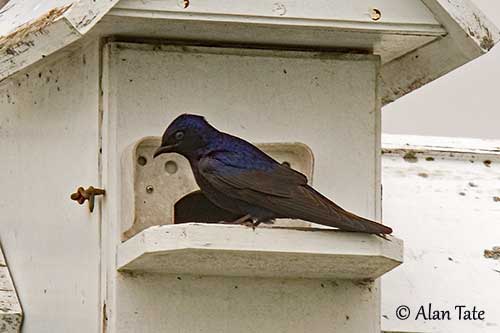
Fr: Hirondelle noire
Ang: Purple Martin
All: Purpurschwalbe
Esp: Golondrina Purpúrea
Ita: Rondine purpurea
Nd: Purperzwaluw
Sd: blå storsvala
Photographers:
Jean Michel Fenerole
Photos d’Oiseaux du monde
Tom Grey
Tom Grey's Bird Pictures & Tom Grey's Bird Pictures 2
Jean-Claude Jamoulle
A la rencontre des Oiseaux
Alan & Ann Tate
AA Bird Photography
Text by Nicole Bouglouan
Sources:
HANDBOOK OF THE BIRDS OF THE WORLD Vol 9 - by Josep del Hoyo - Andrew Elliot - David Christie - Lynx Edicions - ISBN: 8487334695
BIRDS OF THE GREAT BASIN – by Fred A. Ryser - Univ of Nevada Pr -ISBN: 0874170796
Wikipedia, the free encyclopaedia
All About Birds (Cornell Lab of Ornithology)
Department of Energy & Environmental Protection
Bird Web (Seattle Audubon Society)
Purple Martin
Progne subis
Passeriformes Order – Hirundinidae Family
INTRODUCTION:
The Purple Martin is the largest swallow of North America and one of the most popular birds. They are highly social birds, often nesting in colonies and roosting together. They are long-distance migrants, wintering in a large northern half of South America.
The Purple Martin has declined in W North America, and it is currently declining in the east too, where the population depends largely on artificial birdhouses. Since 19th century, competition for nesting cavities with introduced species such as House Sparrow and Common Starling, and forest clearance to remove dead trees, may be a cause of declines.
The Purple Martin is currently evaluated as Least Concern, but conservation measures are suggested in order to protect this beautiful swallow.

DESCRIPTION OF THE BIRD:
Biometrics:
Length: 19 cm
Weight: 48-64 g
The Purple Martin adult male of nominate race has iridescent, dark purple-blue plumage overall, except for wings and tail which are brown-black. The tail is moderately forked. Tufts of white feathers are concealed on body sides.
The black bill is slightly hooked. The eyes are dark brown. Legs and feet are dark grey.
The adult female of nominate race is duller, with grey forehead and hindneck, and dusky grey, finely streaked throat. On the underparts, upper breast and sides are dark brown with pale grey edges to feathers. Rest of underparts is greyish white with dark streaking.
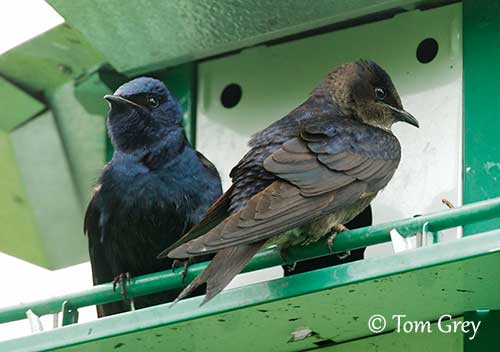
The juvenile is mostly grey-brown on upperparts and throat, whereas rest of underparts is grey-white.
The 1st year male resembles adult female with some blue feathers on head and underparts.
The 1st year female is browner above and paler below than adult.
RANGE AND SUBSPECIES:
The Purple Martin has three subspecies that differ in size and female’s plumage.
P.s. arboricola of western mountains occurs E to Rocky Mountains and S to NW and N Mexico, including N Baja California. It probably winters in South America.
This race is the largest and females have paler underparts.
P.s. subis (described above) breeds in eastern and mid-western North America, E of Rocky Mountains, from S Canada, S to S USA, and C Mexican highlands.
P.s. hesperia of Mexico and SW USA probably winters in South America.
The plumage is similar to “arboricola” but this one is the smallest.
HABITAT:
The Purple Martin can be found in towns, farms, or semi-open country near water such as ponds and marshes. In the western part of the breeding range, it also frequents mountain forest and saguaro desert.
This species is usually more local in the west, and isolated colonies are established around forest edges or in clearings in mountain forest, but also in lowland saguaro desert.
In the east, it breeds in a variety of semi-open areas providing nest-sites near pond or river.
It occurs mostly up to 2,600 metres of elevation.
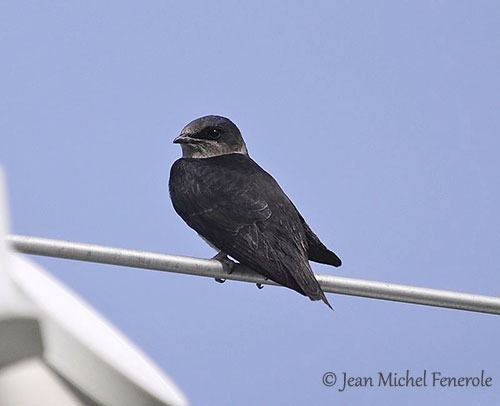
CALLS AND SONGS: SOUNDS BY XENO-CANTO
The Purple Martin is usually fairly noisy, producing a wide variety of sounds. The rich, throaty calls are described as “tchew-wew”, “pew-pew”, “choo” and “cher”.
During the courtship, the male produces a gurgling, guttural “croak” song. It also utters a dawn song similar to the previous but softer. The alarm call is “zweet” or “zwrack”, whereas the territorial call is “hee-hee”.
Some different song structures are reported between western montane and eastern populations.
BEHAVIOUR IN THE WILD:
The Purple Martin is an aerial insect-eater and catches insects from the air, rarely coming to the ground, or mostly in harsh weather.
It feeds on various flying insects and wasps, winged ants and some bees, but mainly true bugs, flies, beetles, moths and butterflies, and also dragonflies. Some spiders are taken too.
The Purple Martin forages primarily in the air, flying low over water but also quite high at times. They are agile hunters.
Some recent research indicates that this species also feeds on Solenopsis invicta, an invasive fire ant.
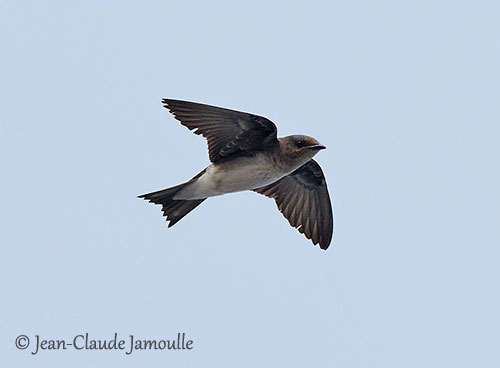
The male arrives before the female at breeding sites, and first establishes the territory. The Purple Martin usually nests in colonies in the east, in artificial nest-boxes. However, in the west, they may nest in loose colonies or even as isolated pairs.
They are monogamous, although occasional polygyny is reported (less than 5%). The male defends a small nesting territory and the female a smaller one. Both adults often mate outside of their pair-bond. Both mates visit several cavities and then, they choose a site.
Once the young fledge, the adults gather at large roosts, often in thousands in late summer, prior to the southern migration. This behaviour continues during the winter.
The Purple Martin is migratory, with most of them wintering in the Amazon basin. They return in early spring (February) in the east, and usually later in spring in the west (April/May). They migrate overland through Mexico and Central America.
The Purple Martin is a good flier and flies with rapid wingbeats interspersed with glides. They are very agile while hunting insects.
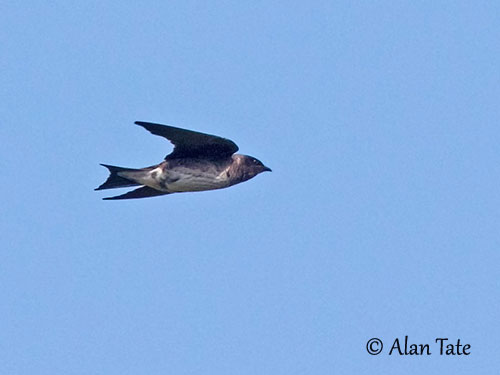
REPRODUCTION OF THIS SPECIES:
The breeding season varies, depending on the range, with the laying from late March in Florida to mid-June in Canada.
The Purple Martin nests in isolated pairs or in groups of less than 35 pairs, although 300 or more are reported. They nest in cavities such as old woodpecker hole, crevice in rock or cliff, or cavity in buildings, streetlamps, and also in artificial birdhouses or gourd-shaped nest-boxes.
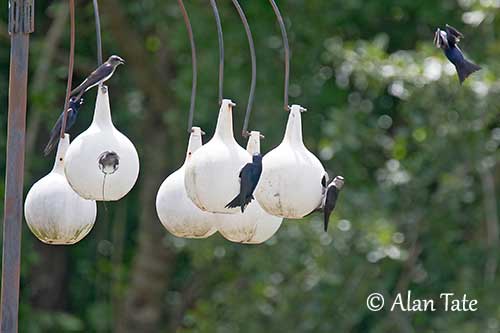
The nest is built by both adults with twigs, stems and leaves, debris and mud. There is sometimes a raised rim in front, to protect the eggs.
The female lays 3-6 white eggs and incubates during 15-18 days. Both parents feed the chicks. The young fledge between 26 and 31 days after hatching. Completion for nest-sites may involve nest failure.
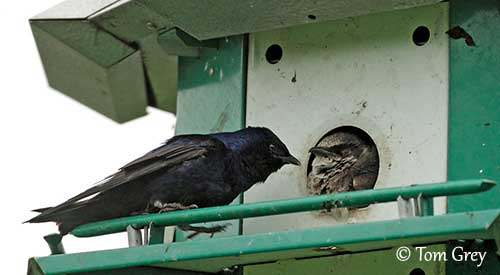
PROTECTION / THREATS / STATUS:
The Purple Martin is threatened by competition for nest-sites with the introduced House Sparrow and Common Starling, and by forest clearance of dead trees in some areas. This species is vulnerable to cold and wet weather, especially in northern part of the range. On the wintering grounds, harassment by humans at roost-sites and use of pesticides may reduce the numbers.
The population is estimated to number 11,000,000 individuals, with both declines and some increase according to the range. Provision of birdhouses is very important for the eastern population.
But currently, the Purple Martin is considered not globally threatened and evaluated as Least Concern.
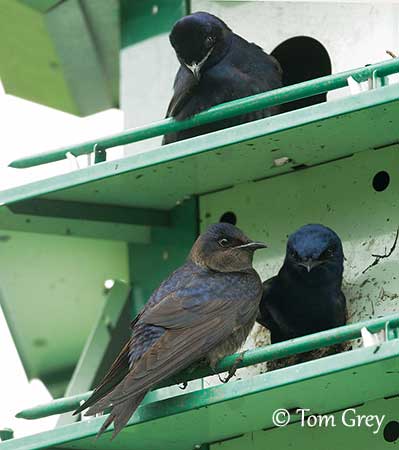
MALE above
PAIR below